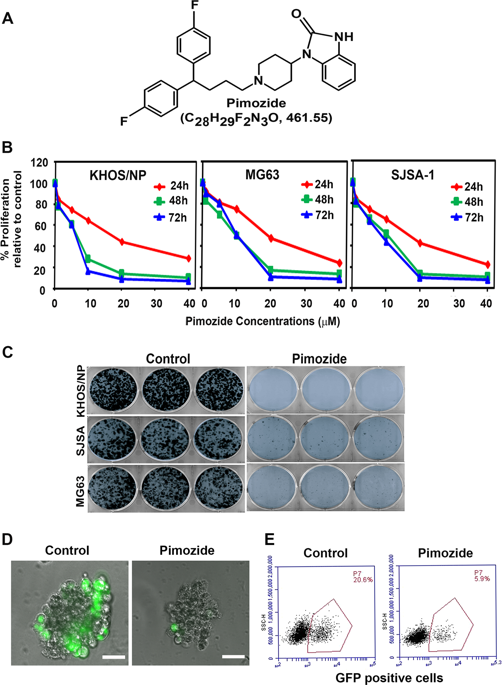当前位置:
X-MOL 学术
›
Cell Death Dis.
›
论文详情
Our official English website, www.x-mol.net, welcomes your
feedback! (Note: you will need to create a separate account there.)
Suppressing STAT5 signaling affects osteosarcoma growth and stemness.
Cell Death & Disease ( IF 8.1 ) Pub Date : 2020-02-24 , DOI: 10.1038/s41419-020-2335-1 Dharmalingam Subramaniam 1 , Pablo Angulo 2, 3 , Sivapriya Ponnurangam 1 , Prasad Dandawate 1 , Prabhu Ramamoorthy 1 , Pugazhendhi Srinivasan 1 , Tomoo Iwakuma 1, 2 , Scott J Weir 1 , Katherine Chastain 2, 4 , Shrikant Anant 1
Cell Death & Disease ( IF 8.1 ) Pub Date : 2020-02-24 , DOI: 10.1038/s41419-020-2335-1 Dharmalingam Subramaniam 1 , Pablo Angulo 2, 3 , Sivapriya Ponnurangam 1 , Prasad Dandawate 1 , Prabhu Ramamoorthy 1 , Pugazhendhi Srinivasan 1 , Tomoo Iwakuma 1, 2 , Scott J Weir 1 , Katherine Chastain 2, 4 , Shrikant Anant 1
Affiliation

|
Osteosarcoma (OS) is the most common primary bone tumor that primarily affects children and adolescents. Studies suggested that dysregulation JAK/STAT signaling promotes the development of OS. Cells treated with pimozide, a STAT5 inhibitor suppressed proliferation and colony formation and induced sub G0/G1 cell cycle arrest and apoptosis. There was a reduction in cyclin D1 and CDK2 expression and Rb phosphorylation, and activation of Caspase-3 and PARP cleavage. In addition, pimozide suppressed the formation of 3-dimensional osteospheres and growth of the cells in the Tumor in a Dish lung organoid system. Furthermore, there was a reduction in expression of cancer stem cell marker proteins DCLK1, CD44, CD133, Oct-4, and ABCG2. More importantly, it was the short form of DCLK1 that was upregulated in osteospheres, which was suppressed in response to pimozide. We further confirmed by flow cytometry a reduction in DCLK1+ cells. Moreover, pimozide inhibits the phosphorylation of STAT5, STAT3, and ERK in OS cells. Molecular docking studies suggest that pimozide interacts with STAT5A and STAT5B with binding energies of -8.4 and -6.4 Kcal/mol, respectively. Binding was confirmed by cellular thermal shift assay. To further understand the role of STAT5, we knocked down the two isoforms using specific siRNAs. While knockdown of the proteins did not affect the cells, knockdown of STAT5B reduced pimozide-induced necrosis and further enhanced late apoptosis. To determine the effect of pimozide on tumor growth in vivo, we administered pimozide intraperitoneally at a dose of 10 mg/kg BW every day for 21 days in mice carrying KHOS/NP tumor xenografts. Pimozide treatment significantly suppressed xenograft growth. Western blot and immunohistochemistry analyses also demonstrated significant inhibition of stem cell marker proteins. Together, these data suggest that pimozide treatment suppresses OS growth by targeting both proliferating cells and stem cells at least in part by inhibiting the STAT5 signaling pathway.
中文翻译:

抑制 STAT5 信号传导会影响骨肉瘤的生长和干性。
骨肉瘤(OS)是最常见的原发性骨肿瘤,主要影响儿童和青少年。研究表明,JAK/STAT 信号传导失调可促进 OS 的发展。用匹莫齐特(一种 STAT5 抑制剂)处理的细胞可抑制增殖和集落形成,并诱导亚 G0/G1 细胞周期停滞和凋亡。细胞周期蛋白 D1 和 CDK2 表达以及 Rb 磷酸化减少,Caspase-3 和 PARP 裂解激活。此外,匹莫齐特还抑制了碟形肺类器官系统中肿瘤细胞的生长和三维骨球的形成。此外,癌症干细胞标记蛋白 DCLK1、CD44、CD133、Oct-4 和 ABCG2 的表达减少。更重要的是,DCLK1 的简写形式在骨球中上调,而匹莫齐特则抑制了这种表达。我们通过流式细胞术进一步证实了 DCLK1+ 细胞的减少。此外,pimozide 抑制 OS 细胞中 STAT5、STAT3 和 ERK 的磷酸化。分子对接研究表明,pimozide 与 STAT5A 和 STAT5B 相互作用,结合能分别为 -8.4 和 -6.4 Kcal/mol。通过细胞热位移测定证实结合。为了进一步了解 STAT5 的作用,我们使用特定的 siRNA 敲低了这两种亚型。虽然蛋白质的敲低不会影响细胞,但 STAT5B 的敲低可减少匹莫齐特诱导的坏死,并进一步增强晚期细胞凋亡。为了确定匹莫齐特对体内肿瘤生长的影响,我们在携带 KHOS/NP 肿瘤异种移植物的小鼠中每天腹膜内施用匹莫齐特,剂量为 10 mg/kg BW,持续 21 天。匹莫齐特治疗显着抑制异种移植物的生长。 蛋白质印迹和免疫组织化学分析也证明了干细胞标记蛋白的显着抑制作用。总之,这些数据表明匹莫齐特治疗至少部分通过抑制 STAT5 信号通路来靶向增殖细胞和干细胞,从而抑制 OS 生长。
更新日期:2020-02-24
中文翻译:

抑制 STAT5 信号传导会影响骨肉瘤的生长和干性。
骨肉瘤(OS)是最常见的原发性骨肿瘤,主要影响儿童和青少年。研究表明,JAK/STAT 信号传导失调可促进 OS 的发展。用匹莫齐特(一种 STAT5 抑制剂)处理的细胞可抑制增殖和集落形成,并诱导亚 G0/G1 细胞周期停滞和凋亡。细胞周期蛋白 D1 和 CDK2 表达以及 Rb 磷酸化减少,Caspase-3 和 PARP 裂解激活。此外,匹莫齐特还抑制了碟形肺类器官系统中肿瘤细胞的生长和三维骨球的形成。此外,癌症干细胞标记蛋白 DCLK1、CD44、CD133、Oct-4 和 ABCG2 的表达减少。更重要的是,DCLK1 的简写形式在骨球中上调,而匹莫齐特则抑制了这种表达。我们通过流式细胞术进一步证实了 DCLK1+ 细胞的减少。此外,pimozide 抑制 OS 细胞中 STAT5、STAT3 和 ERK 的磷酸化。分子对接研究表明,pimozide 与 STAT5A 和 STAT5B 相互作用,结合能分别为 -8.4 和 -6.4 Kcal/mol。通过细胞热位移测定证实结合。为了进一步了解 STAT5 的作用,我们使用特定的 siRNA 敲低了这两种亚型。虽然蛋白质的敲低不会影响细胞,但 STAT5B 的敲低可减少匹莫齐特诱导的坏死,并进一步增强晚期细胞凋亡。为了确定匹莫齐特对体内肿瘤生长的影响,我们在携带 KHOS/NP 肿瘤异种移植物的小鼠中每天腹膜内施用匹莫齐特,剂量为 10 mg/kg BW,持续 21 天。匹莫齐特治疗显着抑制异种移植物的生长。 蛋白质印迹和免疫组织化学分析也证明了干细胞标记蛋白的显着抑制作用。总之,这些数据表明匹莫齐特治疗至少部分通过抑制 STAT5 信号通路来靶向增殖细胞和干细胞,从而抑制 OS 生长。











































 京公网安备 11010802027423号
京公网安备 11010802027423号